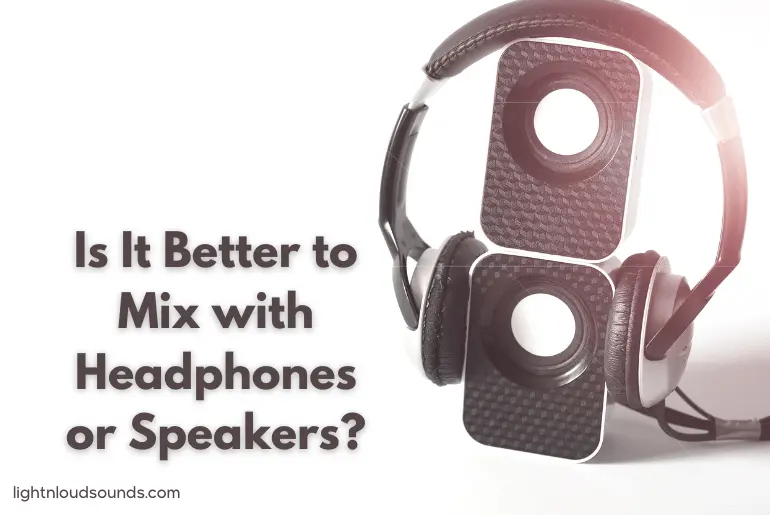The art of mixing music is a delicate balance of technical precision and creative intuition. One foundational decision every sound engineer, producer, or DIY musician grapples with is the choice between mixing with headphones or speakers. This choice is not just about convenience or comfort but about the nuances of sound perception, fidelity, and how listeners will ultimately experience the final mix.
In this post, I will talk about these two options, how they affect production, and which choice is better for you.
Post Contents
Is It Better to Mix with Headphones or Speakers?
Mixing with headphones or speakers has its advantages and drawbacks. Headphones offer a closer, isolated listening experience, making it easier to detect minute details and imperfections, especially in noisy environments. On the other hand, speakers provide a more accurate representation of how music will sound in open spaces and allow for a better sense of spatial arrangement in the mix. Many professionals recommend using both, starting with speakers to get a broad perspective and then switching to headphones for finer details to ensure the mix translates well across various listening scenarios.
What Are the Pros and Cons of Mixing With a Speaker?
Pros
1. Natural environment
Mixing on speakers gives a more real-world representation of how the music will sound in an open space or in the environments where listeners will typically experience the mix.
2. Stereo field representation
It’s easier to judge stereo width, panning decisions, and spatial effects on speakers as they provide a clear distinction between the left and right channels.
3. Better low-end perception
Large studio monitors can reproduce lower frequencies more accurately than most headphones, allowing for better judgments about bass and kick levels.
4. Avoid ear fatigue
Mixing on speakers, especially at moderate volume levels, can be less fatiguing over extended periods compared to headphones.
5. Crosstalk
Natural crosstalk occurs with speakers, where each ear hears a bit of what’s coming out of both speakers. This can provide a more organic phase relationship and stereo image.
Cons
1. Room acoustics
The sound from speakers interacts with the room. If the room is not acoustically treated, this can introduce reflections, standing waves, and other issues that can mislead your perception of the mix.
2. Higher cost for accuracy
Achieving flat frequency response and accurate sound reproduction can be more expensive with speakers, especially when factoring in the cost of room treatment.
3. Volume deception
There’s a tendency to mix louder on speakers, which can give a false sense of excitement and energy in the mix. Over time, this can also lead to ear fatigue or even damage.
5. Space requirements
Good speaker placement necessitates a certain amount of space, and not everyone has the luxury of a dedicated, appropriately sized mixing room.
6. Disturbance
Unlike headphones, using speakers can be disruptive to others, especially in shared or non-isolated environments.
What Are the Pros and Cons of Mixing With a Headphone?

Pros
1. Isolation
Headphones allow for a more isolated listening experience, eliminating room acoustics from the equation. This can be especially beneficial when working in untreated or unpredictable environments.
2. Detail clarity
The proximity of headphone drivers to the ear can reveal subtle details, imperfections, or noise in a mix that speakers might miss.
3. Convenience
Headphones are portable and can be used in various settings, from professional studios to coffee shops or on-the-go setups.
4. Cost-effective
High-quality headphones can be less expensive than high-quality monitors, especially when factoring in the potential costs of room treatment.
Cons
1. Unnatural stereo image
Due to the complete separation of left and right channels in headphones, the stereo image can sometimes feel exaggerated or less natural compared to speakers.
2. Low-end deception
Many headphones, especially consumer models, might either overemphasize or lack the low-end, leading to challenges in accurately gauging bass frequencies.
3. Ear fatigue
Extended sessions with headphones can lead to ear fatigue or even hearing damage, especially if volumes are high.
4. Lack of crosstalk
Unlike speakers, headphones don’t have the natural crosstalk where each ear hears both channels, which can affect the perception of phase relationships and stereo imaging.
5. Comfort
Long mixing sessions might be uncomfortable for some individuals, depending on the design and fit of the headphones.
Factors to Consider Before Choosing Between Speaker or Headphones
1. Environment and acoustics
Consider where you’ll be mixing most often. If you’re in a space with poor acoustics and no possibility for sound treatment, headphones might offer a more accurate listening experience. However, a well-treated room would pair well with speakers.
2. Budget
Quality headphones are generally more affordable than quality speakers, especially when factoring in additional costs like room treatment for speakers. Determine your budgetary constraints before deciding.
3. Accuracy and frequency response
Whether you’re choosing headphones or speakers, ensure they have a flat and broad frequency response to provide a true representation of the sound. Some headphones might boost certain frequencies, and not all speakers provide a clear low-end.
4. Portability and flexibility
If you’re constantly on the move or have multiple workspaces, headphones offer a portability advantage. Speakers require a more static, dedicated space for optimal results.
5. Purpose and end listener experience
Think about how and where the majority of your audience will listen to the mix. If they’re likely to use headphones, then mixing primarily on headphones makes sense. A combination of emphasis on speakers might be more appropriate for broader audiences or mixes intended for various playback systems.
Conclusion
In the end, the decision to mix with headphones or speakers boils down to personal preference, the specifics of one’s environment, and the intended listening context of the finished track. While headphones offer intimacy and detail, speakers provide a sense of space and a real-world representation. Many professionals advocate for a combination approach, using both mediums to capture the strengths of each and ensure the broadest translation possible.

